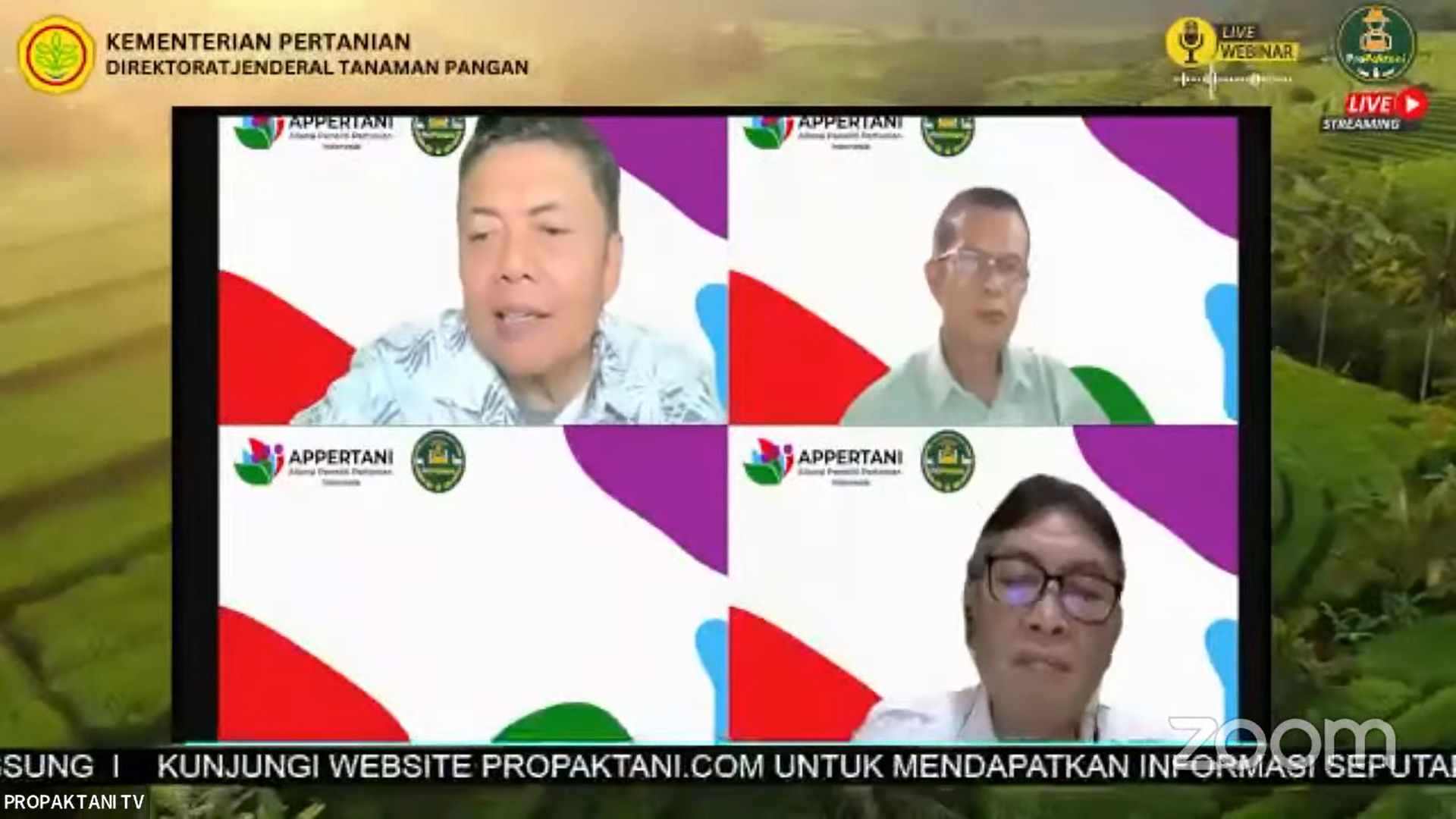Online Socialization and Technical Guidance (WEBINAR) #EPISODE 1173 PROPAKTANI

Environmentally Friendly Pest and Disease Management in Food Crops Supports Sustainable Agricultural Systems
The Green Revolution succeeded in increasing the production of national staple food crops until it achieved self-sufficiency for rice for the first time in 1984. The negative impact that has been felt so far is the increase in pests and diseases because of irrational use of pesticides and the negative impact of climate change. The Green Revolution needs to be continued into a Sustainable Green Revolution to meet domestic and even export needs not only for the current generation, but also for future generations by managing natural resources with a technological orientation and modern institutional changes to realize sustainable agriculture. Propaktani episode 1173 organized by APPERTANI discussed the topic: Environmentally Friendly Pest and Disease Management in Food Crops Supporting Sustainable Agricultural Systems for the main food crop commodities of rice, corn and soybeans. The moderator of this webinar episode is Prof. Dr. Marwoto, APPERTANI Expert Team in the Field of Food Crop Pests and Diseases.

Prof. Dr. Ir. I Nyoman Widiarta, Expert on Plant Pests and Diseases, APPERTANI, who is also a BRIN Researcher, delivered the topic: “Environmentally Friendly Main Pest and Disease Control Strategies in Rice Plants Support Sustainable Modern Agriculture” discuss the success story of the adoption of the Green Revolution in the Five Farmer Business packages supported by the BIMAS Movement, INSUS, SUPER INSUS to the National Rice Production Improvement Program (P2BN) has succeeded in leading Indonesia to achieve rice self-sufficiency several times. The increase in pest and disease attacks as a negative impact of unbalanced fertilizer use, irrational application of pesticides, is exacerbated by the negative impact of climate anomaly. La-Nina is often referred to as a wet drought with a strong intensity that can increase the area of attack of the main pests of rice (rats, rice stem borers, brown planthoppers), as well as the main diseases of rice (tungro, rice dwarf virus, blasts, bacterial leaf blight). In La-Nina with weak intensity, only brown planthoppers, tungro disease and rice dwarf virus have increased in attack. Nationally, the losses due to rice disease pest attacks are not significant, but for small farmers with a land area of less than 0.5 ha, the loss of yield is very significant. Integrated Pest Management integrated in integrated crop management (PTT) is recommended to make plants healthy and the natural control components and natural enemies’ function to maintain the balance of the ecosystem that does not cause pest and disease explosions.
Prof. Ir. Amran Muis, Ph.D. BRIN researchers and the APPERTANI Expert Team in the Field of Plant Pests and Diseases delivered material with the topic: “Management of Important Pests and Diseases of Environmentally Friendly Corn Plants to Support Sustainable Agriculture” emphasizing efforts to manage downy mildew and corn armyworm, fall armyworm (FAW) (Spodoptera frugiperda Smith), a new pest in corn plants in Indonesia. Downy mildew attacks young corn plants so that sometimes the plant cannot produce cobs. Yield loss due to downy mildew ranges from 50-80% in several corn development center areas such as East Java, South Sulawesi and West Kalimantan. The impact of downy mildew not only causes a decrease in production, but also causes trauma for the community to replant corn. Mildew-resistant varieties have been widely produced, in addition to technical culture, biopesticides and nano-biopesticides have also been produced. FAW control can be done with preventive measures, the use of biological control agents (predators, parasitoids) of insect pathogens, and registered biopesticides.
Prof. Dr. Yusmani Prayogo, M.Si, . BRIN researchers and the APPERTANI Expert Team in the Field of Plant Pests and Diseases delivered material with the topic: “Environmentally Friendly Pest and Disease Management in Soybean Plants to Support Sustainable Agricultural Systems“. Soybean plants can be attacked by 16-28 types of insects with yield loss of up to 80% and infected by 3 soilborne diseases, 3 airborne diseases, 5 viral diseases and 2 bacterial diseases. Some of the factors that trigger the explosion of pests and diseases include: 1) susceptible varieties, 2) pesticide resistance and/or resurgence, 3) late and variable control, 4) negative impacts of global climate change, and 5) farmers’ lack of knowledge about pest bioecology and disease epidemiology. The success rate of pest and disease management is determined by 5 things, namely: 1) understanding of pest bioecology and disease epidemiology, 2) routine (scheduled) monitoring, 3) fulfilling the 5 right methods in the use of pesticides, 4) control actions are not too late, and 5) the right choice of control technology. Technical guidance is needed so that control technology recommendations can be implemented massively

